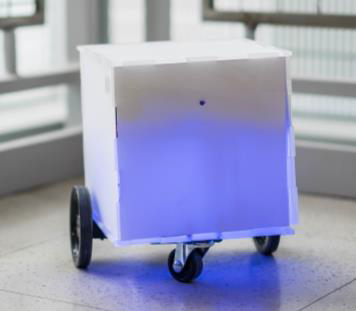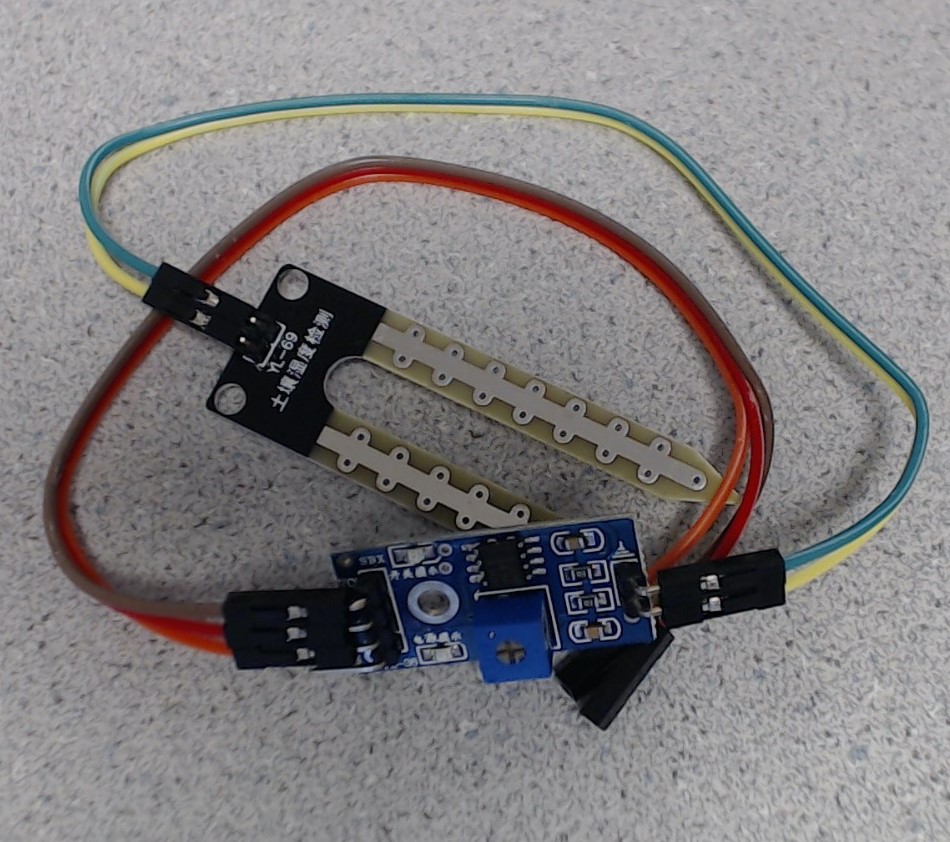Code and Parts
FinalDemo.py
#!/usr/bin/python
# Final Script to Control All functions of the Autonomous Robot
from picamera import PiCamera
from picamera.array import PiRGBArray
import RPi.GPIO as GPIO
import smtplib
import time
import math
import os
# Importing OpenCV
import cv2
import cv2.cv as cv
import numpy as np
import sys
# GPIO setup
GPIO.setmode(GPIO.BCM) # set as broadcom
# Define the BCM channels for sensors
sensor1 = 17 #green
sensor2 = 27 #red
sensor3 = 22 #yellow
# Define the BCM channel for the water pump
pump = 26
# Initialize the GPIOs
GPIO.setup(sensor1, GPIO.IN, pull_up_down=GPIO.PUD_UP)
GPIO.setup(sensor2, GPIO.IN, pull_up_down=GPIO.PUD_UP)
GPIO.setup(sensor3, GPIO.IN, pull_up_down=GPIO.PUD_UP)
GPIO.setup(6, GPIO.OUT)
GPIO.setup(13,GPIO.OUT)
GPIO.setup(5, GPIO.OUT)
GPIO.setup(pump, GPIO.OUT)
# Define the pulse, duty cycle, and frequency calculations
hc = 0.00130
hdcC = hc/(hc + 0.02)*100
hfrC = 1/(0.02 + hc)
ha = 0.00165
hdcA = ha/(ha + 0.02)*100
hfrA = 1/(0.02 + ha)
qc = 0.001472
qdcC = qc/(qc + 0.02)*100
qfrC = 1/(0.02 + qc)
qa = 0.00155
qdcA = qa/(qa + 0.02)*100
qfrA = 1/(0.02 + qa)
pulse = 0.0015
dc = pulse/(pulse+ 0.02)*100
fr = 1/(0.02 + pulse)
pL = GPIO.PWM(6,fr)
pR = GPIO.PWM(13,fr)
arm = GPIO.PWM(5,fr)
# Start servos as close to stop
pL.start(0)
pR.start(0)
arm.start(0)
# FUNCTIONS
def moveArm(t):
arm.ChangeDutyCycle(qdcC)
arm.ChangeFrequency(qfrC)
curTime = time.time() + t
while time.time() < curTime:
pass
arm.ChangeDutyCycle(0)
def backArm(t):
arm.ChangeDutyCycle(qdcA)
arm.ChangeFrequency(qfrA)
curTime = time.time() + t
while time.time() < curTime:
pass
arm.ChangeDutyCycle(0)
def turnLeftSlow(t):
pL.ChangeDutyCycle(hdcC)
pL.ChangeFrequency(hfrC)
pR.ChangeDutyCycle(hdcC)
pR.ChangeFrequency(hfrC)
curTime = time.time() + t
while time.time() < curTime:
pass
pL.ChangeDutyCycle(0)
pR.ChangeDutyCycle(0)
return
def turnRightSlow(t):
pL.ChangeDutyCycle(hdcA)
pL.ChangeFrequency(hfrA)
pR.ChangeDutyCycle(hdcA)
pR.ChangeFrequency(hfrA)
curTime = time.time() + t
while time.time() < curTime:
pass
pL.ChangeDutyCycle(0)
pR.ChangeDutyCycle(0)
return
# Green Sensor callback
def sensor1_callback(channel):
if GPIO.input(channel):
print "sensor1 on"
else:
print "sensor1 off"
if("sensor1" not in needsWater):
needsWater.append("sensor1")
# Red Sensor callback
def sensor2_callback(channel):
if GPIO.input(channel):
print "sensor2 on"
else:
print "sensor2 off"
if("sensor2" not in needsWater):
needsWater.append("sensor2")
# Yellow Sensor callback
def sensor3_callback(channel):
if GPIO.input(channel):
print "sensor3 on"
else:
print "sensor3 off"
if("sensor3" not in needsWater):
needsWater.append("sensor3")
GPIO.add_event_detect(sensor1, GPIO.FALLING, callback=sensor1_callback, bouncetime=300)
GPIO.add_event_detect(sensor2, GPIO.FALLING, callback=sensor2_callback, bouncetime=300)
GPIO.add_event_detect(sensor3, GPIO.FALLING, callback=sensor3_callback, bouncetime=300)
# Define OpenCV capture video
cap = cv2.VideoCapture(0)
# Define the queue
needsWater = []
i = 0
now = time.time()
adjust = 1
# Define cx and cy
cx = -1
cy = -1
# Start with state 0, initializing, and try to find (non-existant black tag)
state = 0
findColor = 'black'
blackLB = (0,0,0)
blackUB = (0,0,0)
colorLB = blackLB
colorUB = blackUB
# Define the half size of the screen
halfScreen = 350
##### INITIALIZE VIDEO AND CAPTURE TO RGB MATRIX #####
global camera, rawCapture
camera = PiCamera()
camera.framerate = 15
rawCapture = PiRGBArray(camera)
time.sleep(0.5)
########### COLOR MAIN LOOP RECOGNITION ##############
pixel_size = 200
for frame in camera.capture_continuous(rawCapture, format="bgr", use_video_port = True):
image = frame.array
imageRaw = image.copy()
greenLB= (50,100,0)
greenUB = (100, 255, 140)
redLB = (169,136,103)
redUB = (179,225, 206)
yellowLB = (10,50,100)
yellowUB = (80,230,230)
if(findColor == "red"):
colorLB = redLB
colorUB = redUB
elif(findColor == "yellow"):
colorLB = yellowLB
colorUB = yellowUB
elif(findColor == "green"):
colorLB = greenLB
colorUB = greenUB
else:
colorLB = blackLB
colorUB = blackUB
hsv = cv2.cvtColor(image, cv2.COLOR_BGR2HSV)
mask = cv2.inRange(hsv, colorLB, colorUB)
mask = cv2.erode(mask, None, iterations =2 )
mask = cv2.dilate(mask, None , iterations =2 )
# Ensure no stray element is detected as tag
contours = cv2.findContours(mask.copy(), cv2.RETR_EXTERNAL, cv2.CHAIN_APPROX_SIMPLE)[-2]
for c in contours:
if cv2.contourArea(c) > pixel_size:
################# CENTROID OF THE TAG ##################
M = cv2.moments(c)
cx = int(M["m10"]/ M["m00"])
cy = int(M["m01"] / M["m00"])
# Define contour and center
cv2.drawContours(image, [c] , -1, (0,255,255), 2 )
cv2.circle(image, (cx,cy), 7, (255,255,255), -1 )
# Display on console for debugging
#cv2.imshow("RAW", imageRaw)
#cv2.imshow("Threshold", mask)
#cv2.imshow("overlay", image)
print cx, cy
key = cv2.waitKey(1) & 0xFF
rawCapture.truncate(0)
if( key == ord("q") ):
break
print needsWater
print state
print findColor
###################### STATE MACHINE #########################
# STATE 0: Initializing
if state == 0:
if needsWater == []:
findColor = 'black'
cx = -1
cy = -1
elif needsWater[0]=='sensor2':
cx = -1
cy = -1
state = 4
findColor = 'red'
elif needsWater[0] == 'sensor1':
cx = -1
cy = -1
state = 2
move = 1
findColor = 'green'
elif needsWater[0] == 'sensor3':
cx = -1
cy = -1
state = 1
move = 1
findColor = 'yellow'
else:
findColor = 'black'
cx = -1
cy = -1
# STATE 1: Turn Left towards Yellow/Sensor3
elif state == 1:
if cx > 0 and cy > 0:
state = 3
elif move == 1:
turnLeftSlow(0.3)
now = time.time() + 1
move = 0
elif time.time() >= now:
move = 1
else:
pass
# STATE 2: Turn Right towards Green/Sensor1
elif state == 2:
if cx > 0 and cy > 0:
state = 3
elif move == 1:
turnRightSlow(0.2)
now = time.time() + 1
move = 0
elif time.time() >= now:
move = 1
else:
pass
# STATE 3: Adjusting
elif state == 3:
if cx < (halfScreen*1.1) and cx > (halfScreen*0.9):
if findColor == 'yellow' or findColor == 'green':
state = 4
elif findColor == 'red':
state = 0
else:
pass
elif cx > (halfScreen*1.1) and adjust == 1:
turnRightSlow(0.1)
adjust = 0
adjustTime = time.time() + 1
elif cx < (halfScreen*0.9) and adjust == 1:
turnLeftSlow(0.1)
adjust = 0
adjustTime = time.time() + 1
else:
if time.time() >= adjustTime:
adjust = 1
# STATE 4: WATERING PLANT
elif state == 4:
# Lowers arm and turns on pump
moveArm(0.7)
GPIO.output(pump, True)
time.sleep(1)
# Turns off pump and raises arm
GPIO.output(pump, False)
backArm(0.6)
# Remove from queue
if(findColor == 'red'):
needsWater.remove('sensor2')
print 'Was here'
elif(findColor == 'green'):
needsWater.remove('sensor1')
print 'remove sensor1'
elif(findColor == 'yellow'):
needsWater.remove('sensor3')
print 'remove sensor3'
else:
pass
state = 5
# STATE 5: Return to center
elif state == 5:
if findColor == 'yellow':
findColor = 'red'
cx = -1
cy = -1
state = 2
elif findColor == 'green':
findColor = 'red'
cx = -1
cy = -1
state = 1
# If red
else:
state = 0
cx = -1
cy = -1
findColor = 'black'



